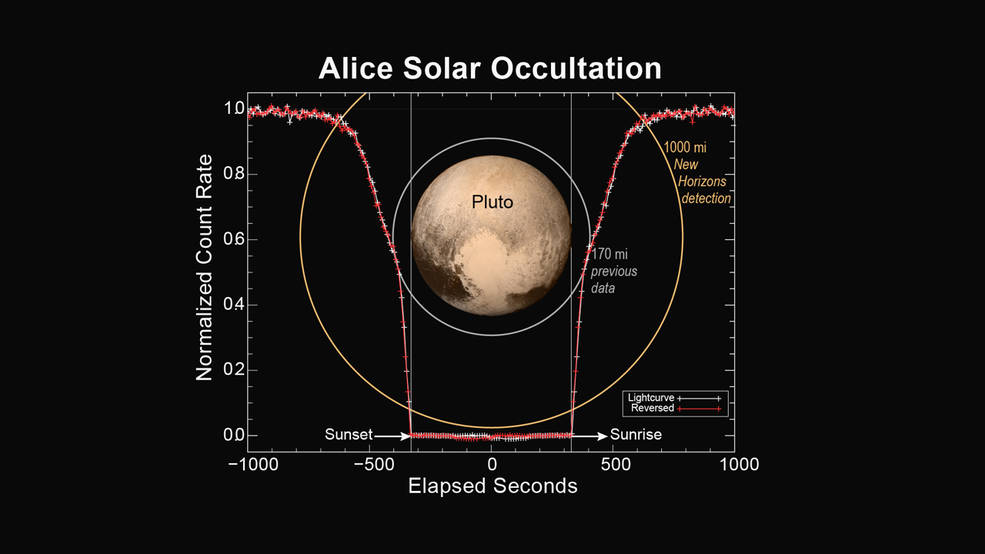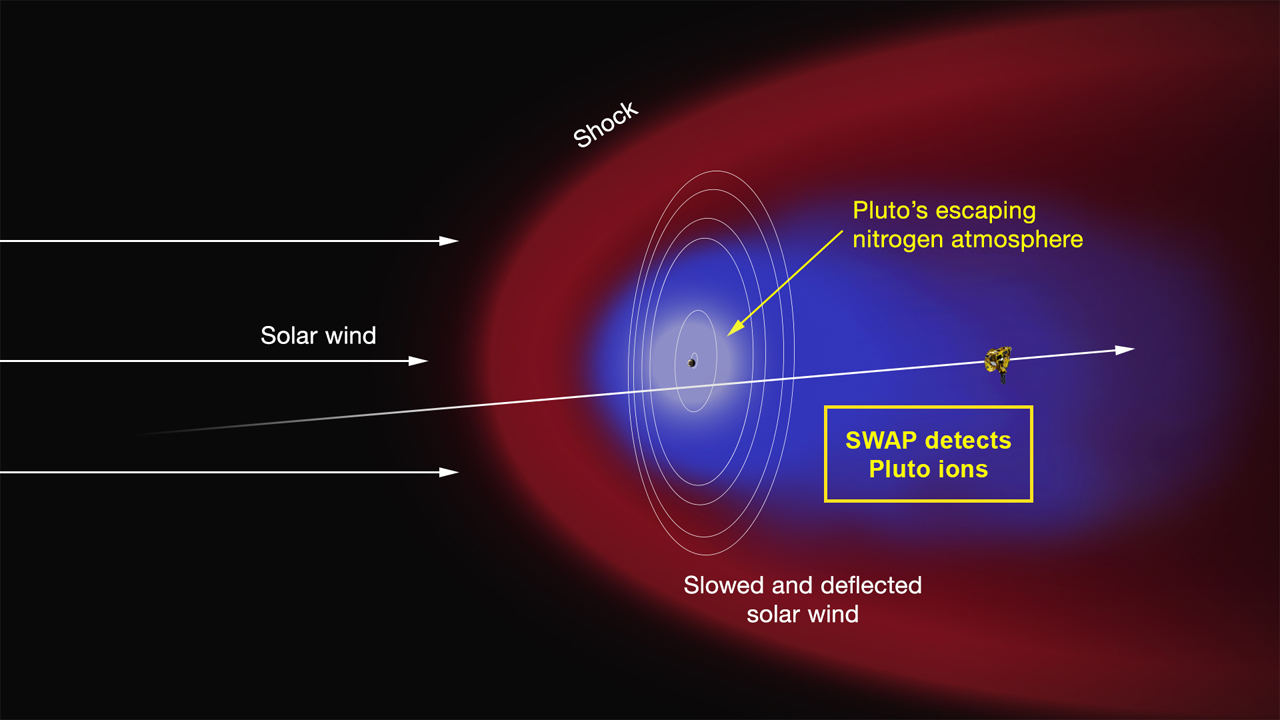New Horizons Observes Pluto's Extended Atmosphere Being Stripped By Solar Wind
by Sophia Nasr, @Pharaoness
New atmospheric observations released by the New Horizons science team have revealed Pluto’s atmosphere extends way out to 1600 km (1000 miles) from Pluto’s surface. This observation marks the first time scientists have seen Pluto’s atmosphere more than 270 kilometers (170 miles) above its surface. The data was taken when New Horizons slipped into Pluto’s shadow on July 14th and observed as the Sun’s light passed through the dwarf planet's atmosphere.
"This is only the beginning for Pluto atmospheric science" says New Horizons scientist Andrew Steffl of the Southwest Research Institute in Boulder, Colorado. "Next month, the full Alice occultation dataset will be sent to Earth for analysis. Even so, the data we have now show that Pluto’s atmosphere rises higher above its surface, in relative terms, than does the Earth’s."
The Alice Solar Occultation image seen below is the light curve of the data taken by New Horizons’ Alice instrument, showing sunlight reaching Pluto’s surface. You can tell it reaches its surface because the curve sharply bottoms out. The upper part of the curve represents the atmosphere’s nitrogen content, the mid part, methane, and the lower part, heavy hydrocarbons. The curve is rather consistent on either side as well, indicating that Pluto’s atmosphere is even throughout the dwarf planet. We still don’t know whether Charon has any traces of an atmosphere as the data has not been transmitted back, as was stated by Alan Stern during the briefing on July 17th.
Video caption: This animation shows how the count rate observed by New Horizons’ Alice instrument decreases as Pluto’s atmosphere passes in front of the sun. The decreasing count rate is due to the ultraviolet sunlight having to pass through progressively larger amounts of the atmosphere as the spacecraft line of sight gets closer to Pluto. The observed count rates are compared with predictions based on two plausible models of Pluto’s atmosphere: a "turbulent" case, where the expected count rate is relatively large, due to small amounts of sunlight-absorbing hydrocarbons in the lower atmosphere, and a "stagnant" case, where much larger hydrocarbon abundances are predicted. The preliminary count rate data from Alice are matched by neither model, but are closer to the stagnant case. Credit: NASA/JHUAPL/SwRI


Pluto’s Exospheric Ion Tail!

In an interesting discovery, it turns out that the interaction of the solar winds with Pluto’s exosphere gives Pluto an ion tail. This is the area that New Horizons co-investigator Fran Bagenal, University of Colorado, Boulder, who leads the New Horizons Particles and Plasma team, specializes in—plasma physics. Bagenal is one of the scientists who answered some of my questions for my article on Pluto’s atmosphere, so I know just how excited she was (and is) about the New Horizons mission ("GO NEW HORIZONS!" is how she ended one of her emails back to me; I responded with much the same sentiment).
The graphic above shows what the interaction of the solar winds—outflows of charged particles sent hurtling out by the Sun—with Pluto’s mainly molecular nitrogen atmosphere, looks like. New Horizons’ SWAP instrument detected a region of cold and dense gas that extends tens of thousands of miles beyond Pluto, created as its atmosphere is stripped and carried away by the solar winds. A "cavity" in the solar winds was detected some 77,000 km (48,000 miles) to 109,000 km (68,000 miles) away from Pluto, containing ionized nitrogen that form a "plasma tail", which is what you see in the graphic. Ionized nitrogen was also detected by the PEPSSI instrument before New Horizons reached its closest approach to Pluto.
One of the things that continues to boggle my mind is the rate at which Pluto’s atmosphere is being stripped. At the briefing on July 17th, Bagenal stated that Pluto’s nitrogen atmosphere is being stripped away at an astounding rate of 500 tons per hour. For comparison, the escape rate of Mars’ atmosphere is about 1 ton per hour. If you add up the nitrogen Pluto has lost roughly over the age of the dwarf planet (some 4.6 billion years), you find it would form a layer of nitrogen ice up to 9,000 feet thick. "That’s a substantial mountain of nitrogen ice that’s been removed", says Bagenal.
At the briefing, Bagenal explained that the methane gas in Pluto’s atmosphere, a greenhouse gas that absorbs heat, heats up the atmosphere enough to give it the required energy to escape. "This is just a first tantalizing look at Pluto’s plasma environment," says Bagenal. "We’ll be getting more data in August, which we can combine with the Alice and Rex atmospheric measurements to pin down the rate at which Pluto is losing its atmosphere. Once we know that, we’ll be able to answer outstanding questions about the evolution of Pluto’s atmosphere and surface and determine to what extent Pluto’s solar wind interaction is like that of Mars."
NASA’s New Horizons spacecraft, now over 9 million km (5.6 million miles) away from Pluto, is traveling out into the Kuiper Belt, a region in the outer reaches of the solar system. As it travels outwards, the data taken by the spacecraft during closest approach will be transmitted over a period of 16 months. The science isn’t even close to over yet. As Dwayne Brown so perfectly stated when he closed the briefing on July 17th, "Science Never Sleeps".
 Sophia Nasr is an astrophysics student at York University. Actively involved in the astronomical community at York U, she is the President of the Astronomy Club at York University and a member of the team at the York University Observatory. She also is involved in university projects, and holds a position in research on dark matter at York U. Holding scientific outreach dear, Sophia is actively involved in social media outlets such as Facebook, Twitter, and Google Plus, where she shares with the world her passion for the universe and how it works.
Sophia Nasr is an astrophysics student at York University. Actively involved in the astronomical community at York U, she is the President of the Astronomy Club at York University and a member of the team at the York University Observatory. She also is involved in university projects, and holds a position in research on dark matter at York U. Holding scientific outreach dear, Sophia is actively involved in social media outlets such as Facebook, Twitter, and Google Plus, where she shares with the world her passion for the universe and how it works.







